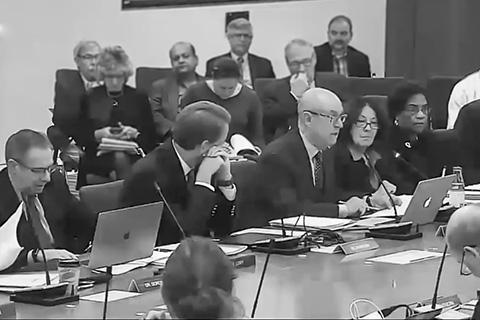The future of the Frederick National Laboratory (FNL) and its large initiatives was at the forefront of the recent Frederick National Laboratory Advisory Committee (FNLAC) meeting held in Shady Grove. Here are a few excerpts, accompanied by time stamps from the videocast.
00:36:43 – Sharpless: FNL in an “Interesting Time”
NCI Director Norman Sharpless, M.D., delivered the first presentation of the day, providing an overview of cancer research in 2018, NCI’s work, and his visions for the future.
After the remarks, FNLAC member Klaus Hahn, Ph.D., asked Sharpless to describe how FNL fits into the larger picture of NCI.
“It is an interesting time for the Frederick National Lab,” Sharpless said. “We are going to have to make some important decisions about the directions we should take scientifically and administratively.”
Sharpless added that, due to FNL’s importance, FNLAC and NCI should focus on ways to maximize FNL’s unique capabilities without diminishing its usefulness or proposing that it undertake unnecessary projects.
01:13:22 – FNL and NCI Leaders Developing Plans to Refine FNL’s Efforts
Ethan Dmitrovsky, M.D., laboratory director of FNL, reviewed FNL’s recent achievements, including memorandums of understanding as well as progress by the ATOM Consortium, RAS Initiative, and National Cryo-Electron Microscopy Facility.
During the question-and-answer session, FNLAC member Piermaria Oddone, Ph.D., asked whether FNL is looking for areas where it can improve the larger scientific community.
“We have a number of plans in place of ways that we can better serve and direct and prioritize … the work of Frederick National Laboratory,” Dr. Dmitrovsky said.
Dr. Dmitrovsky also said that he has met with Sharpless and is regularly meeting with Doug Lowy, M.D., NCI deputy director, to collaborate on these efforts.
01:29:45 – Nature of FNL’s Next Contract Still Being Decided
Lowy in turn described FNL’s current contract and the upcoming bridge contract. He said that the current model, where the majority of FNL’s work supports extramural research, “is something that [NCI] would like to continue but augment.”
He also explained possibilities for the post-bridge contracting environment, such as a single contractor (like the current model), separate contractors for administrative and scientific functions, a corporate contractor working in partnership with academia, and an exclusively academic contractor. However, Lowy emphasized that no decisions have been made.
In the lengthy discussion that ensued, Sharpless indicated that FNLAC appears to have little interest in a split contract or a solely academic one.
02:23:00 – PDMR a Useful Resource with Much Potential
After a break for lunch, James Doroshow, Ph.D., updated the committee about the FNL-supported NCI Patient-Derived Models Repository (PDMR).
So far, PDMR has facilitated cancer research by providing over 500 models of cancer to more than 50 laboratories and private organizations at a very modest cost.
The PDMR staff has also been conducting preclinical trials using the models to explore drug efficacy and standardize its definition, which could help other groups’ drug development efforts.
“Are we going to get effective clinical trials by using this for screening? … That’s the really high bar,” Doroshow said.
They currently aim to make another 30–50 models available each quarter.
03:12:25 – Framework Established for Cell Therapy Facility
Anthony Welch, Ph.D., reported on the efforts of FNL’s Biopharmaceutical Development Program (BDP) to establish the new CAR T-cell therapy facility mentioned by Sharpless during the May FNLAC meeting.
BDP has developed a timeline for the facility’s launch, though they are still in the planning stage. They are currently collaborating with government and academic groups to develop the logistics for manufacturing and trials-support processes. Other projects, such as testing the equipment and determining how the facility can best serve the scientific community, are also underway.
“This isn’t a trivial manufacturing enterprise when you’re trying to do something like this,” Welch said.
04:11:04 – Stahlberg: One-Year-Old ATOM Consortium Completes Early Stages of Plan
Eric Stahlberg, Ph.D., told FNLAC that the Accelerating Therapeutics for Opportunities in Medicine (ATOM) Consortium has made considerable progress in its first year. Consortium staff have successfully set up the groundwork for data and modeling efforts, generated computational models, and begun exploring ways to use simulations to help predict the success of drug candidates.
“The ATOM effort has concluded the first phase of its research plan and has just initiated the second phase, but even in that first phase, several things have already been brought to the fore,” Stahlberg said.
In addition, several external groups have taken an interest in ATOM, including pharmaceutical companies and three Department of Energy national laboratories.
04:54:47 – Tuveson: RAS Initiative Is Unusual but Exciting
Dwight Nissley, Ph.D., concluded the day’s presentations with a report on the FNL-led RAS Initiative, which has greatly expanded the scientific community’s understanding of RAS biology.
FNL and Initiative scientists have solved the structure of the KRAS protein, identified novel classes of compounds that target it, and continued to develop tools and leads for current studies and eventual clinical trials. In 2018 alone, FNL’s RAS Reagents Core has generated thousands of resources for RAS researchers.
David Tuveson, M.D., Ph.D., co-chair of the RAS Ad Hoc Working Group, subsequently commented that the Initiative is a “pretty unusual space program in the cancer field, but it looks like it has real legs and it’s exciting to those of us who are advising.”
The videocast time stamp for each presentation can be found below.
00:00:04 – Lawrence Marnett: Opening Remarks
00:04:59 – Norman Sharpless: Report from the NCI Director
00:38:26 – Ethan Dmitrovsky: Frederick National Laboratory for Cancer Research (FNLCR): Current Work and Future Directions
01:16:01 – Doug Lowy: A Future Perspective on the FNLCR
02:23:00 – James Doroshow: NCI Mouse Repository: Utilization and Future Directions
03:12:25 – Anthony Welch: Biopharmaceutical Development Program (BDP) and Cell Therapy Facility Development
03:50:27 – Eric Stahlberg: Update: Accelerating Therapeutics for Opportunities in Medicine
04:26:49 – Dwight Nissley and David Tuveson: RAS Initiative: Progress and Working Group Update
05:05:38 – Open Discussion


